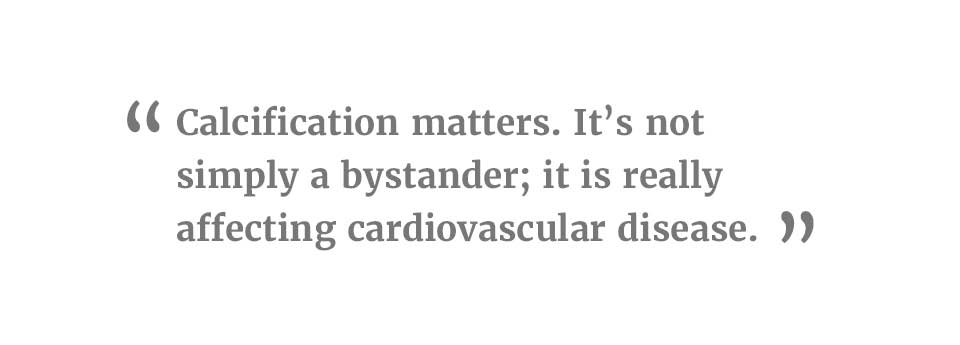In this three-part blog series, Dr. Jeffrey Bland and Dr. Leon Schurgers explain the science behind the interaction of warfarin and vitamin K in the body, how this interaction could lead to vascular calcification, and the potential ways to reverse the calcification process.
Warfarin, Vitamin K and Calcification
When the body uses vitamin K in blood clotting, the vitamin K is recycled through a redox reaction. Warfarin prevents clotting by blocking the recycling enzyme in this reaction. But this inhibition of vitamin K in the vasculature by warfarin may be detrimental.
Vascular smooth muscle cells are crucial to healthy arteries. These cells produce matrix Gla protein, or MGP. In the presence of high vitamin K, MGP is carboxylated, thereby blocking bone morphogenetic proteins and the switching of smooth muscle cells to what is called a pathological phenotype. This also blocks the crystallization and the nucleation of calcium salts.
But in the presence of low vitamin K, either from diet or induced by a vitamin K antagonist like warfarin, the result is uncarboxylated MGP, which is an inactive protein. This results in a switching of smooth muscle cells to a pathological phenotype; they shed what is called extracellular vesicles, the aforementioned nucleic calcium phosphate. The result is a cycle of apoptosis, or cell death.
Active Vascular Calcification
The buildup of calcium in tissue, or vascular calcification, has long been viewed as a passive process: always present and correlating with disease. But a few researchers, including Dr. Schurgers, have theorized that vascular calcification is not clinically inert.
A meta-analysis co-authored by Dr. Schurgers showed it doesn’t matter where the calcification in the vasculature is—whether it is in the peripheral arteries, coronary arteries, carotid arteries or aorta. If calcification is present at any vascular site, a person’s risk of dying or having a cardiovascular event increases by three to four times, according to the 2009 paper Dr. Schurgers co-authored and published in the journal Vascular Health and Risk Management.
Another research group from Emory University used CT scanning to measure calcification in the arteries. In 2009, their paper in Nature Reviews Cardiology found that the coronary artery calcification score is a better predictor than the complete Framingham risk score. Calcification matters. It’s not simply a bystander; it is really affecting cardiovascular disease.

Vascular Calcification Sites
There are two sites in the vasculature that calcify. One is in the medial layer of the arterial wall, which is linked to stiffness, hypertension and vascular remodeling. Normally, this calcification appears as linear crystal deposits along elastin.
Then there is also the intimal calcification in the intimal layer of the arterial wall. Intimal calcification is associated with atherosclerosis, a condition in which plaque made up of fat, cholesterol and calcium builds up in the arteries. Over time, the plaque hardens and narrows the arteries. Dr. Schurgers and other researchers hoped to show that warfarin not only affects medial calcification but also intimal calcification.
Vitamin K Studies in Animals
In one animal study, researchers used a vitamin K deficiency and warfarin to rapidly calcify the arteries of rats. Within two weeks of an induced vitamin K deficiency, the first signs of calcification could be seen in the vasculature. With warfarin, the first signs of calcification in the mice could be observed in three to five weeks of treatment, according to the 1998 paper published in the journal Arteriosclerosis, Thrombosis, and Vascular Biology.
In another experiment, Dr. Schurgers and colleagues gave mice warfarin for seven days, 28 days or 49 days. Imaging showed mice with a vitamin K deficiency, and mice taking warfarin had an increase in calcification pressure both in the heart and in the aorta. The first signs of calcification pressure present in the vasculature appeared in just seven days of the experiment.
The researchers also measured what is called pulse wave velocity, or vascular stiffness, in these animals. Upon warfarin treatment, the pulse wave velocity went up, indicating a kind of hypertension in these mice. After 49 days, it went even higher. The researchers concluded that taking an oral anticoagulation with vitamin K antagonist—in this case, it was warfarin—results in medial vascular calcification associated with vascular muscle loss and parameters of vascular stiffening.
Vitamin K Studies in Humans
In a collaboration with the department of cardiology in Maastricht University, Dr. Schurgers and colleagues screened low-risk atrial fibrillation patients that were treated with vitamin K antagonists. The patients were stratified at the beginning of the study by risk factors, such as the Framingham risk factor score. In patients younger than 65 years that did not receive a vitamin K antagonist, 75 percent of this group had an Agatston score between zero and 10, meaning no visible calcification.
In the patients that were treated longer than 60 months with vitamin K antagonist, 50 percent of the patients had an Agatston score between 100 and 400, meaning significant presence of vascular calcification in the coronary arteries. This change was even more pronounced in the patients who were older than 65 years. Among the 65 years or older patients that did not receive warfarin, about half of them had no visible calcification in the coronary arteries. Among those 65 years or older patients with vitamin K antagonist treatment longer than 60 months, 50 percent had a calcification score above 400, which means these patients had very stiff coronary arteries.
In another collaboration with Rikshospitalet University in Oslo, Dr. Schurgers and colleagues studied 150 aortic stenosis patients. The researchers measured MGP in the patients, including the fraction of MGP that was not phosphorylated and not carboxylated. This portion of MGP has no negative charge in the protein, low affinity for calcium phosphate, and is easily set free in the circulation.
The patients with a good vitamin K status had a very good survival, while the patients with a poor vitamin K status had a poor survival over the course of the study: They had a 5.3 times higher chance of dying if they were vitamin K deficient. And, among those patients who also took vitamin K antagonist, their chance of dying increased from 5.3 times higher to 9.1 times higher.
Check out part 3 of New Frontiers in Cardiovascular Medicine: Vitamin K2 as MK-7—or part 1, if you missed it.

Jeffrey Bland, PhD, FACN, CNS has been an internationally recognized leader in the nutritional medicine field for over 35 years and is known for his ability to synthesize complex scientific concepts in a manner that is both personable and accessible. A biochemist by training, Dr. Bland earned dual degrees in biology and chemistry from the University of California, Irvine and completed his PhD in organic chemistry at the University of Oregon. He is a Fellow of both the American College of Nutrition where he is a Certified Nutrition Specialist and the Association for Clinical Biochemistry.

Leon Schurgers, PhD is a Senior Scientist and Professor of Biochemistry of Vascular Calcification at the Cardiovascular Research Institute Maastricht (CARIM), Maastricht University. Prof. Schurgers’
work includes molecular biology, biochemistry, animal and human nutrition, pharmacology, and clinical studies in the fields of vascular disease. He is leading the scientific part on vitamin K research and supervising technical engineers, post docs,
and PhD students.
Prof. Schurgers is a member of the International society on Thrombosis and Haemostasis as well as the American Heart Association. He has published more than 130 research papers in the international scientific press.




